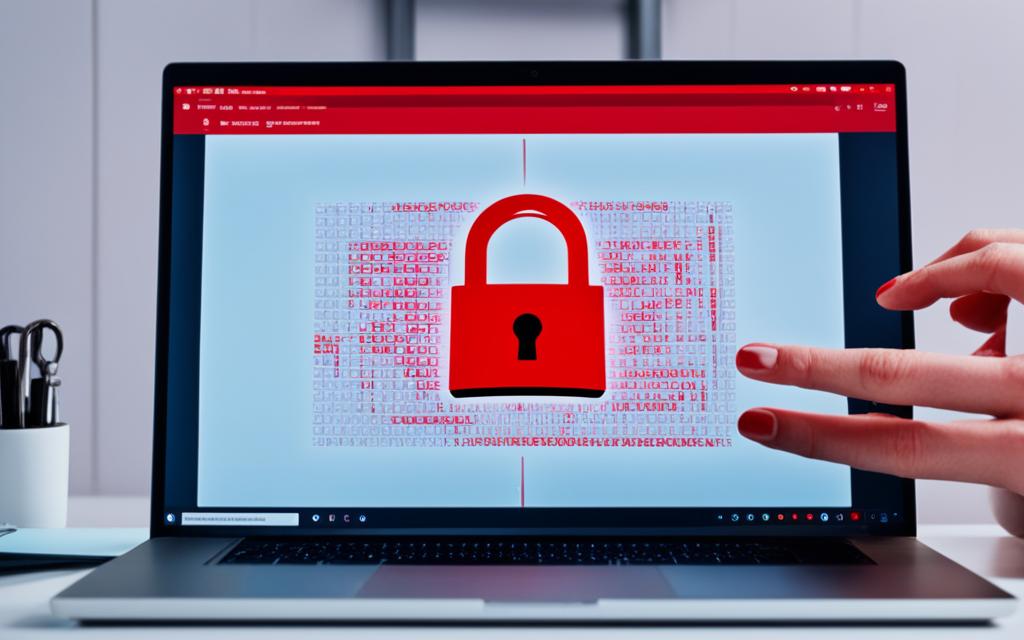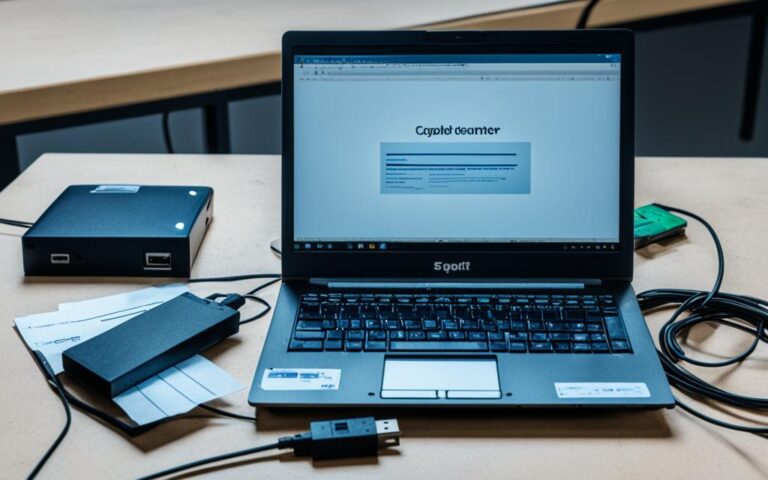How to Handle Ransomware Attacks: Data Recovery Tips
Welcome to our comprehensive guide on handling ransomware attacks and recovering your valuable data. Ransomware attacks have become increasingly common, posing significant threats to businesses and individuals alike. In this article, we will equip you with essential tips and strategies to effectively handle ransomware attacks and ensure successful data recovery.
Dealing with a ransomware attack can be daunting, but with the right knowledge and tools, you can minimize the impact and regain control over your data. We will discuss methods to prevent ransomware, the importance of having a recovery plan, and steps to take when recovering encrypted files. Additionally, we will introduce you to Cloudian HyperStore, an innovative solution for ransomware data recovery.
Whether you’re a small business owner, an IT professional, or an individual concerned about the safety of your personal data, our comprehensive guide will provide you with valuable insight to overcome ransomware attacks and protect your critical information. Let’s dive in and explore the world of ransomware attack recovery and data protection.
What Is a Ransomware Attack?
A ransomware attack is a malicious cyberattack that involves the use of malware to encrypt systems and data. Attackers deploy malware onto a victim’s device or network, which then spreads and encrypts files, rendering them inaccessible to the rightful owner. The attackers then demand a ransom, usually in cryptocurrency, in exchange for the decryption key that allows the victim to regain access to their data.
These attacks exploit vulnerabilities in computer systems and can infiltrate networks through various vectors, including phishing emails, malicious websites, or software vulnerabilities. Once the malware is executed, it begins to encrypt files using advanced encryption algorithms, making it extremely difficult, if not impossible, for the victim to decrypt the data without the attacker’s key.
A ransomware attack is a serious threat to individuals, businesses, and organizations of all sizes. The attackers often set strict deadlines for ransom payment, adding urgency and psychological pressure on the victims. Failure to comply with the demands may result in the permanent loss of data or its public exposure, leading to reputational damage and potential legal consequences.
In addition to the immediate financial impact of paying the ransom, organizations may also face significant costs associated with remediation, system downtime, incident response, and legal fees. Moreover, if personal or sensitive information is compromised during a ransomware attack, it can lead to severe regulatory and compliance issues, including data breach notifications and potential fines.
Ransomware attacks have become increasingly sophisticated and targeted, with cybercriminals employing various techniques and ransomware strains to maximize their chances of success. It is essential for individuals and organizations to have robust cybersecurity measures in place to prevent these attacks and mitigate their impact.
Notable Ransomware Attacks
| Year | Attack | Target | Ransom Paid |
|---|---|---|---|
| 2017 | WannaCry | NHS, FedEx, Telefonica | $130,000 |
| 2020 | REvil (Sodinokibi) | Garmin | $10 million |
| 2021 | Colonial Pipeline | Colonial Pipeline | $4.4 million |
How to Prevent Ransomware: Building Your Ransomware Data Recovery Strategy
Preventing ransomware is crucial in safeguarding your valuable data. By developing a robust data protection strategy, you can minimize the risk of ransomware attacks and ensure effective data recovery. Here are the key steps to protect yourself:
1. Inventory Your Data
Start by identifying and categorizing your data. Understand its value, sensitivity, and potential impact if compromised. This will allow you to prioritize your protection efforts and allocate resources wisely.
2. Identify Vulnerable Endpoints
Identify the vulnerable entry points that cybercriminals may exploit, such as outdated software, weak passwords, or unpatched systems. Regularly update and patch all software and systems to reduce vulnerabilities.
3. Create a Recovery Plan
Developing a comprehensive recovery plan is crucial to minimize downtime and data loss in the event of a ransomware attack. This plan should include backup and restoration procedures, incident response protocols, and communication strategies.
4. Protect Your Backups
Ensure your backups are securely stored and inaccessible to unauthorized individuals. Implement strong access controls, encryption, and regular testing to confirm the integrity and availability of your backups.
5. Duplicate Data Offsite
Consider duplicating your critical data offsite to separate physical locations or cloud-based storage solutions. This ensures that even if your primary systems are compromised, you can still recover your data from the offsite location.
“Prevention is the best defense against ransomware. By implementing a comprehensive data protection strategy, you can significantly reduce the risk of falling victim to ransomware attacks.” – Cybersecurity Expert
By following these preventive measures, you can strengthen your resilience against ransomware attacks and protect your valuable data. However, it’s important to regularly review and update your strategies to adapt to ever-evolving threats.
| Data Protection Measures | Benefits |
|---|---|
| Regular data backups | Quick data recovery |
| Strong access controls | Prevents unauthorized access |
| Regular software updates and patches | Minimizes vulnerabilities |
| Offsite data duplication | Enhances data redundancy |
| Encryption of sensitive data | Protects data confidentiality |
How to Recover Ransomware Encrypted Files
If you have already been affected by a ransomware attack, there are several methods you can try to recover your encrypted files. The most effective method is to restore from a backup. Regularly backing up your files ensures that you have a copy stored separately from your computer, allowing for quick restoration in case of an attack.
Other methods include:
- Using Windows System Restore
- Utilizing Windows File Versions
- Using data recovery software
- Exploring ransomware decryption tools
The table below summarizes these recovery methods:
| Recovery Method | Description |
|---|---|
| Restore from Backup | Recover files from a separate backup source. |
| Windows System Restore | Roll back your system to a previous state before the ransomware attack. |
| Windows File Versions | Access previous versions of encrypted files using Windows’ file history. |
| Data Recovery Software | Use specialized software to recover encrypted files from your system. |
| Ransomware Decryption Tools | Explore tools developed by cybersecurity experts to decrypt specific ransomware strains. |
Keep in mind that the success of these methods may vary depending on the severity and complexity of the ransomware attack. Consulting with a cybersecurity professional can provide further guidance in recovering your encrypted files.
Ransomware Data Recovery With Cloudian
Cloudian HyperStore is a massive-capacity object storage device that provides secure storage for large amounts of data and enables easier recovery from ransomware attacks. With its redundant power and cooling features, as well as fast data transfer capabilities, Cloudian HyperStore is a reliable solution for safeguarding your data and recovering from ransomware incidents.
When it comes to ransomware data recovery, Cloudian HyperStore offers several key advantages. Its object storage architecture ensures that data remains intact and uncorrupted, even if ransomware encrypts or deletes files on the original server. This allows for efficient recovery without the risk of further data loss.
Cloudian HyperStore’s object storage approach also allows for easy scalability. As your data requirements grow, Cloudian HyperStore can seamlessly expand to accommodate your needs.
In addition to its robust storage capabilities, Cloudian HyperStore includes advanced data protection features. These features include data deduplication, erasure coding, and immutable storage, which help safeguard your data against ransomware attacks and ensure its recoverability.
Cloudian HyperStore’s intuitive user interface simplifies the process of recovering data after a ransomware incident. You can quickly locate and restore specific files or entire file systems, reducing downtime and minimizing the impact on your business operations.
Furthermore, with Cloudian HyperStore’s integrated data replication and disaster recovery capabilities, you can replicate your data to offsite locations, providing an additional layer of protection against ransomware attacks.
Cloudian HyperStore is compatible with various backup and recovery solutions, allowing for seamless integration into your existing data protection infrastructure. Whether you utilize traditional backup software or cloud-based platforms, Cloudian HyperStore can enhance your ransomware data recovery strategy.
In summary, Cloudian HyperStore is an indispensable tool for ransomware data recovery. Its object storage architecture, data protection features, scalability, and ease of use make it a reliable and efficient solution for safeguarding your data and recovering from ransomware incidents.
Importance of Having a Ransomware Recovery Plan
A ransomware recovery plan is a fundamental component for effectively responding to and recovering from ransomware attacks. When organizations fall victim to these malicious attacks, having a well-prepared plan in place can make all the difference in minimizing the impact and facilitating a swift recovery process. Without a comprehensive ransomware recovery plan, businesses risk prolonged downtime, substantial financial losses, and potential damage to their reputation.
One crucial element of a ransomware recovery plan is the establishment of an incident response team. This team should consist of individuals with specialized knowledge and skills in handling cybersecurity incidents. Their prompt and efficient response is vital in containing the attack, mitigating further damage, and identifying the root cause of the breach.
Additionally, a robust communication plan is essential in ensuring coordinated efforts and effective information sharing among key stakeholders. This plan should outline clear lines of communication, including internal notifications, external reporting to relevant authorities, and customer or user communication protocols. Transparent and timely communication is crucial in maintaining trust, managing expectations, and providing updates throughout the recovery process.
Furthermore, a ransomware recovery plan should include step-by-step instructions for data recovery and addressing the threat. This involves identifying and isolating affected systems, restoring data from reliable backups, and implementing enhanced security measures to prevent future attacks. By following a structured recovery process, organizations can regain control of their systems, recover valuable data, and resume normal operations as quickly as possible.
“Having a well-prepared ransomware recovery plan is like having a playbook for an emergency situation. It enables organizations to respond swiftly and methodically, minimizing the impact of an attack and enabling a faster return to business-as-usual.”
Benefits of a Ransomware Recovery Plan:
- Minimizes downtime: A well-executed recovery plan helps organizations reduce downtime by responding promptly and efficiently to ransomware attacks, minimizing the disruption to business operations.
- Reduces financial losses: By having a plan in place, businesses can avoid prolonged downtime and the associated costs, such as lost productivity, revenue, and potential regulatory fines.
- Protects data and ensures business continuity: A recovery plan prioritizes the protection and recovery of valuable data, enabling organizations to maintain business continuity even in the face of a ransomware attack.
- Enhances incident response capabilities: Organizations with a comprehensive recovery plan are better equipped to handle cybersecurity incidents effectively, reducing the time to identify, contain, and remediate the breach.
- Mitigates reputational damage: By responding swiftly and transparently to a ransomware attack, businesses can preserve their reputation and maintain the trust of customers, partners, and stakeholders.
Investing time and resources into developing a ransomware recovery plan is crucial for organizations of all sizes. It provides a proactive approach to cybersecurity, enabling businesses to respond effectively to attacks, safeguard valuable data, and ensure continuity of operations. By implementing a comprehensive recovery plan, organizations can significantly reduce the impact of ransomware attacks and protect their most valuable digital assets.
| Key Components of a Ransomware Recovery Plan | Key Benefits |
|---|---|
| Incident response team | Swift and efficient response to minimize damage |
| Communication plan | Transparent and timely communication with stakeholders |
| Step-by-step recovery instructions | Structured approach to restore systems and data |
| Data backups and redundancy | Quick recovery and minimal data loss |
| Enhanced security measures | Prevention of future attacks |
5 Steps for Ransomware Data Recovery
When recovering from a ransomware attack, it is essential to follow a structured approach. By implementing the following five steps, you can enhance your chances of successful ransomware data recovery:
- Implement an Incident Response Plan: Having an incident response plan in place ensures a swift and effective response to a ransomware attack. This plan should include designated roles and responsibilities, communication protocols, and predefined steps to mitigate the impact of an attack.
- Determine the Attack Style and Isolate Affected Systems: Analyzing the attack style can help identify vulnerabilities and prevent future breaches. Isolating affected systems prevents the spread of ransomware and minimizes further damage to your data and network.
- Regularly Backup Your Data: Regular backups are crucial for ransomware data recovery. By consistently backing up your data, you ensure that you have an up-to-date copy to restore from in case of an attack. Store your backups in a separate and secure location to prevent them from being compromised by ransomware.
- Utilize Data Recovery Software or Decryption Tools: In some cases, data recovery software or decryption tools can help recover encrypted files without paying the ransom. These tools work by attempting to decrypt the files or recovering them from compromised systems. However, their effectiveness may vary depending on the type of ransomware and encryption used.
- Strengthen Security Measures to Prevent Future Attacks: To protect against future ransomware attacks, it’s essential to enhance your security measures. This includes regular software updates, utilizing firewalls and antivirus software, implementing strong access controls, and conducting employee training on identifying phishing attempts and other security risks.
By following these steps, you can improve your chances of recovering your data after a ransomware attack and prevent future incidents.
Comparison of Ransomware Data Recovery Methods
| Recovery Method | Pros | Cons |
|---|---|---|
| Restore from Backup | Highly effective Preserves data integrity Cost-effective |
Requires regular backups May result in data loss if backups are outdated or incomplete |
| Data Recovery Software | Can recover deleted or corrupted files No need to pay ransom No data loss if successful |
May not work for advanced encryption Time-consuming May require technical expertise |
| Ransomware Decryption Tools | May decrypt files without paying ransom No data loss if successful Cost-effective |
Effectiveness varies with ransomware type May not work for all encryption methods May not be available for all ransomware variants |
Remember, ransomware attacks can have devastating consequences for individuals and businesses. Implementing a comprehensive incident response plan, regularly backing up your data, and strengthening your security measures are crucial steps to protect against ransomware and ensure successful data recovery.
Image:
Conclusion
Recovering from a ransomware attack requires a comprehensive approach that includes prevention, data recovery strategies, and strengthening security measures. By following the steps outlined in this guide and having a robust ransomware recovery plan in place, businesses can effectively handle ransomware attacks and safeguard their digital assets.
Prevention is key when it comes to protecting your data from ransomware attacks. Developing a strong data protection strategy, including inventorying your data, identifying vulnerable endpoints, and protecting your backups, is crucial. By implementing these measures, you can significantly minimize the risk of an attack and reduce its impact.
However, even with the best prevention strategies in place, it’s essential to be prepared for the possibility of a ransomware attack. Having a solid ransomware recovery plan ensures that your business can respond swiftly and effectively in the event of an incident. This plan should include an incident response team, clear communication protocols, and step-by-step instructions for data recovery. By being prepared, you can minimize downtime, mitigate financial losses, and protect your business’s reputation.
Remember, ransomware attacks are a serious threat, but with the right approach and a proactive mindset, you can recover from them. Stay vigilant, regularly update your security measures, and educate your employees about cyber threats. By prioritizing data protection and having a comprehensive ransomware recovery plan in place, you can safeguard your business’s valuable data and ensure its long-term success.












